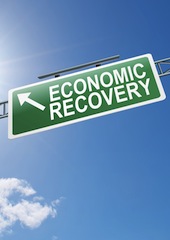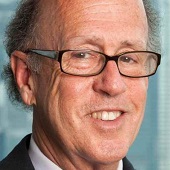America’s False Dawn
Is a classic cyclical revival finally at hand for the United States?
February 4, 2014

Financial markets are in broad agreement that something close to a classic cyclical revival may finally be at hand for the United States. But is it?
At first blush, the celebration seems warranted. Growth in real GDP appears to have averaged close to 4% in the second half of 2013, nearly double the 2.2% pace of the preceding four years.
The U.S. unemployment rate has finally fallen below the 7% threshold. And the Federal Reserve has validated this seemingly uplifting scenario by starting to taper its purchases of long-term assets.
But my advice is to keep the champagne on ice. Two quarters of strengthening GDP growth hardly indicates a breakout from an anemic recovery.
We’ve seen this before
Remember, the same thing has already happened twice since the end of the Great Recession in mid-2009, We have had a 3.4% average annualized gain in the second and third quarters of 2010 and a 4.3% average increase in the fourth quarter of 2011 and the first quarter of 2012. In both cases, the uptick proved to be short-lived.
A similar outcome this time would not be surprising. Indeed, much of the acceleration in GDP growth is due to an unsustainable surge of restocking. Over the first three quarters of 2013, rising inventory investment accounted for 38% of the 2.6% increase in total GDP.
Excluding the inventory swing, annualized U.S. growth in “final sales” to consumers, businesses and the government averaged a tepid 1.6%.
That gets us to the toughest issue of all – the ongoing balance-sheet recession that continues to stifle the American consumer. Accounting for 69% of the U.S. economy, consumer demand holds the key to America’s post-crisis malaise.
In the 17 quarters since “recovery” began, annualized growth in real personal consumption expenditures has averaged just 2.2%. This compares to a pre-crisis trend of 3.6% over the period from 1996 to 2007.
The past: No guide for the present
In the past, when discretionary spending on items such as motor vehicles, furniture, appliances and travel was deferred, a surge of “pent-up demand” was quick to follow.
Not this time. The record plunge in consumer demand during the Great Recession has been followed by persistently subpar consumption growth.
The American consumer remains central in the problem, as the balance sheet repair of households continues to lag – and debt rejection takes precedence over discretionary spending.
This should not be surprising either. The American consumer was, in effect, ground zero in the recent horrific crisis. Far too many U.S. households made enormous bets on the property bubble. They believed that their paper gains were permanent substitutes for stagnant labor income.
Consumers then used these gains to support a record consumption binge. Compounding the problem, they drew freely on a monstrous credit bubble to finance the gap between spending and income-based saving.
American zombies?
When both bubbles burst – first housing, and then credit – asset-dependent U.S. consumers were exposed to the American strain of the Japanese disease first diagnosed by Nomura economist Richard Koo.
Koo has stressed the lingering perils of a balance-sheet recession (see video) centered in the corporate sector of the Japanese economy. But Koo’s analysis is equally applicable to bubble-dependent U.S. consumers.
When the collateral that underpins excess leverage comes under severe pressure – as was the case for Japanese businesses in the early 1990s and American consumers in the mid 2000s – Koo’s so-called “debt rejection” motive of deleveraging takes precedence over discretionary spending.
The Japanese parallels do not stop there. As research by the economists Richard Caballero, Takeo Hoshi and Anil Kashyap has shown, Japan’s corporate “zombies” – rendered essentially lifeless by their balance-sheet problems – ended up damaging the healthier parts of the Japanese economy.
Until balance sheets are repaired, such “zombie congestion” restrains aggregate demand. Japan’s lost decades are an outgrowth of this phenomenon. The United States is now halfway through the first lost decade of its own.
Don’t believe the hype
Indicators of U.S. balance-sheet repair hardly signal the onset of the more vigorous cyclical revival that many believe is at hand. The debt/income ratio for American households is now down to 109% – well below the peak of 135% reached in late 2007. But that is still 35 percentage points above the average over the final three decades of the 20th century.
Similarly, the U.S. personal saving rate stood at 4.9% in late 2013, up sharply from the low of 2.3% in the third quarter of 2005. But it remains 4.4 percentage points below the average recorded from 1970 to 1999. By these measures, U.S. consumers’ balance-sheet repair is, at best, only about half-finished.
Put the foot on the pedal again?
Optimists see it differently. Encouraged by sharp reductions in households’ debt-service costs and a surprisingly steep fall in unemployment, they argue that the long nightmare has finally ended.
The optimistic case for a sustained breakout rests on reduced debt service and falling unemployment – neither of which paints an accurate picture of post-crisis healing.
That may be wishful thinking. Plunging debt service is largely an outgrowth of the Fed’s unprecedented zero-interest-rate policy. As long as the stock of debt remains excessive, U.S. consumers will dismiss the reduction in interest expenses as nothing more than a temporary subsidy from the Fed.
Moreover, the decline in unemployment largely reflects persistently grim labor-market conditions, which have discouraged many workers from remaining in the labor force. If the labor-force participation rate were 66%, as it was in early 2008, rather than 62.8%, as it was reported to be in December 2013, the unemployment rate would be just over 11%, not 6.7%.
Yes, there has been some progress on the road to recovery. But, as Carmen Reinhart and Ken Rogoff have long documented, post-crisis healing is typically slow and painful.
Notwithstanding the Fed’s claims that its unconventional policies have been the elixir of economic renewal in the United States, the healing process still has years to go.
Takeaways
Keep the champagne on ice. Two quarters of strengthening GDP growth are hardly a breakout from an anemic recovery.
Japan has had lost decades. The US is now halfway through the first lost decade of its own.
The US’s economic healing process still has years to go.
US consumers will see the reduction in interest expenses as nothing more than a temporary subsidy from the Fed.
US consumers find themselves exposed to the American strain of the Japanese disease of balance-sheet recession.
U.S. consumers' balance-sheet repair is, at best, only about half-finished.
At 69% of the economy, consumer demand holds the key to America's post-crisis malaise.

